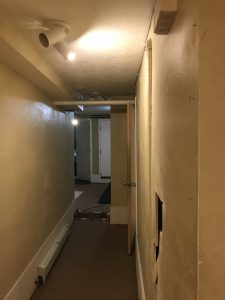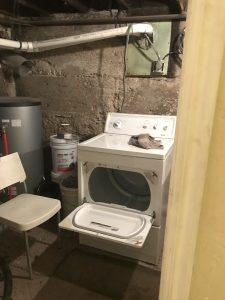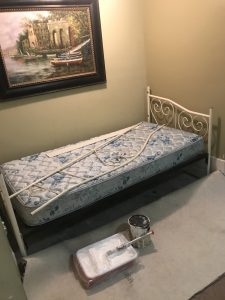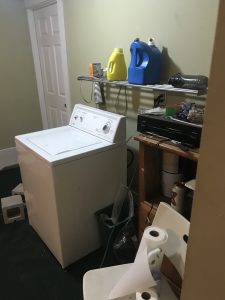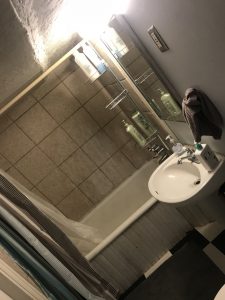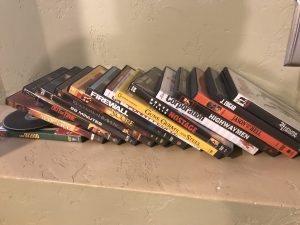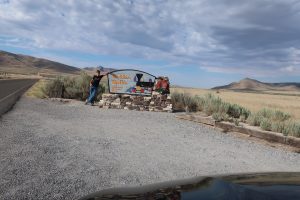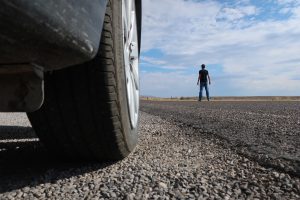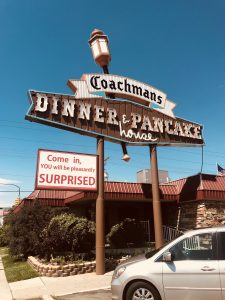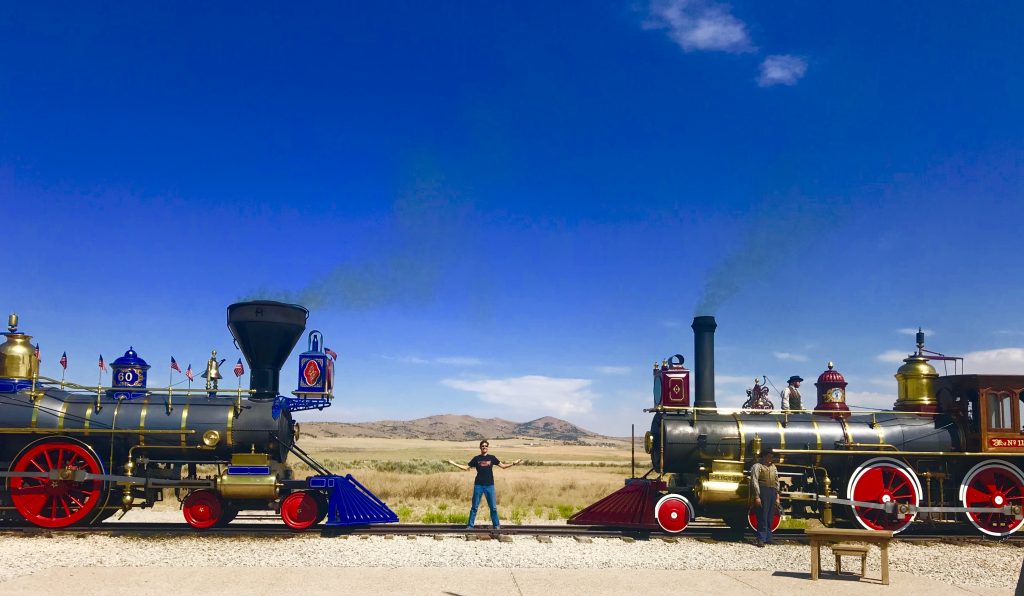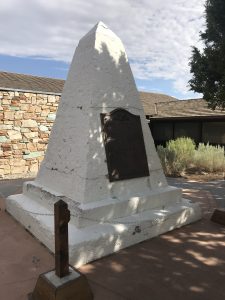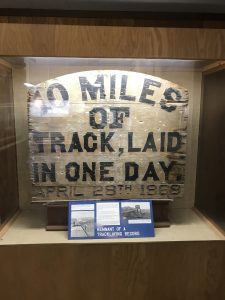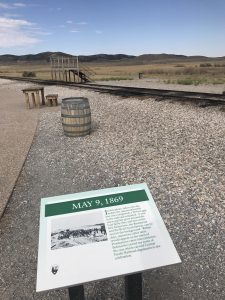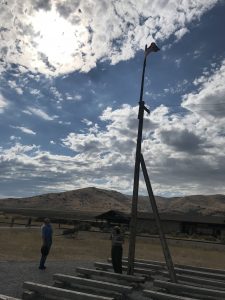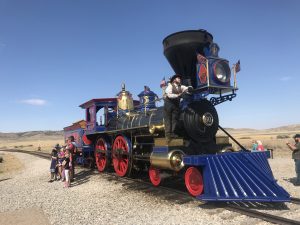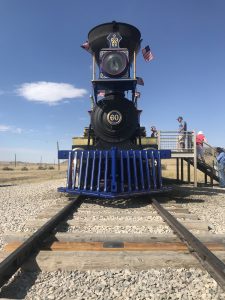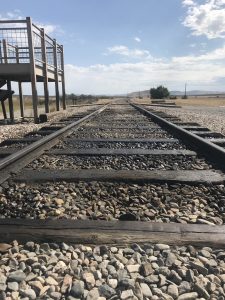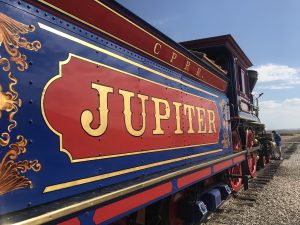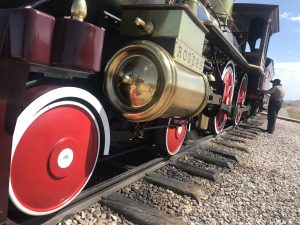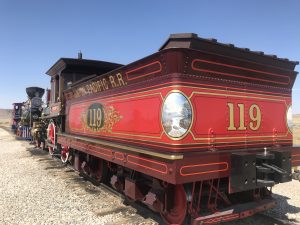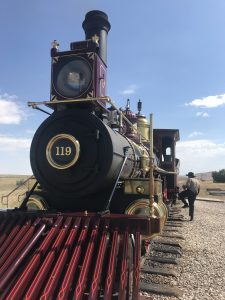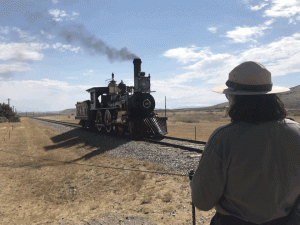And so I leave my murderous SLC AirBNB behind, taking with me memories and photographic evidence in case CSI doesn’t get all the angles they need.
Full disclosure: I’m guiltier than most for having a weird movie collection, both in the physical realm via VHS, Laserdisc, DVD, and blu-ray, as well as cloud based via iTunes and MoviesAnywhere. But I’m always astonished at the sorts of things people have on their shelves — here’s the offerings at this place:
En route to Idaho Falls for a few days rest prior to running another marathon (I just ran in and boy are my legs tired… no, seriously, they’re really, really tired), and I decided to finally stop at the Golden Spike National Historic Site (not to be confused with a National Park, albeit it’s still run by the Park Service). I’ve passed the exit numerous times and was always leery of the 30 mile or so detour off the freeway to go see what essentially amounts to a stick in the ground. But this is history writ large, a moment in the American experiment wherein we changed time itself. Whereas before shipping goods across the country would often require a 6-month sea voyage down around the Cape of Good Hope, the transcontinental railroad could do it in 2 weeks. The nation was connected as never before… and this moment where the Central Pacific and Union Pacific lines converged and joined up marked the end of the Western frontier and the dawn of industrialized “civilization.”
The event was commemorated on May 10, 1869, with the driving of FOUR ceremonial spikes (two of gold, one of silver, and one of composite of gold and silver… but the gold one was the LAST spike). It was all supposed to happen on May 8th, but a pay dispute and the workers chaining up the Union Pacific engine as ransom combined with a slew of other snafus, delayed the ceremony. They also didn’t have a US Flag, despite having two marching bands, the press, and all kinds of other pomp and circumstance. Somebody though had a family heirloom flag in their knapsack and so that was flown… never mind that it was from 1819 and only had 20 stars on it. Sure, sure, in 1869 there were 37 states but, well, this event was all about hitches, so…
Say, here’s another fun fact I gleaned from the Ranger docent — not sure if it’s real or just one of them tourist stories they tell — but back in the day the US had to order their locomotives from Europe. The builders asked if we wanted the ones with the bell for signaling or the ones with the whistles. And being Americans, we said we wanted BOTH the bells and whistles for signaling… hence the term, all the bells and whistles. True? Fiction? Apocryphal? Historical? If we believe Voltaire, all history is a pack of tricks we play on the dead so…
Anyways, I wasn’t sure what to expect when I got there. It really is out in the middle of nowhere:
But it was as if I stopped at the Coachmans Dinner and Pancake House in Salt Lake City, with the famous slogan:
In visiting the Golden Spike Historical Site, I *was* pleasantly surprised. Here’s a shot of me I like to call Hanna on Wheels (an homage to the Hell on Wheels traveling town that followed the workers laying the track, a place of ill repute and blowing off steam to match the steam locomotives that would come).
I was a bit astonished though to learn that everything here is basically a replica “save for the graded gravel” Ranger Katie told me. The original rails were pulled up and scrapped to aid the war effort in 1942. The locomotives were destroyed in the San Francisco earthquake… or something was. Almost had to be the locomotives. In any case, the replicas of the engines were build in the mid-1970s at a cost of US $1 million per. The Jupiter was the Central Pacific train and the 191 was the Union Pacific. The park services originally asked the Walt Disney Company to help, knowing they had some experience with trains, but they were busy on something called The Florida Project, soon to be renamed Walt Disney World. They did send an illustrator to do the murals on the back of the trains so there’s that.
As for the spikes themselves? Well, they were only in the ground long enough for the flash powder to dissipate and then they were replaced with proper, generic, and therefore less expensive ones. Today, two of the final four spikes are at Stanford University and one is at the Union Pacific museum in Council Bluffs, IA. The fourth has been lost to history. At the Golden Spike Historical Site, they only have replica spikes, albeit they are historically accurate in that they have the May 8, 1869, date engraved on them; nobody bothered to fix it when the ceremony was delayed.
***
Tomorrow I’m looking to pump some ibuprofen and slap on some more salonpas in order to jumpstart the recovery of my still smarting legs courtesy of not being too smart. Plus, I’m making a trek out to Atomic City, ID. Maybe after that I won’t need reflective vests for night running; I’ll simply glow in the dark thereafter.
The world is ever changing… just ask the horse right here that was replaced by an iron horse over there… that was replaced by a flying fortress in the sky… that was then brought back for nostalgia’s sake.

